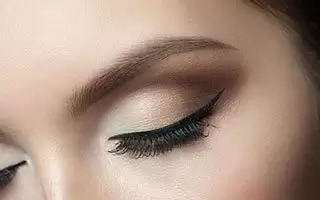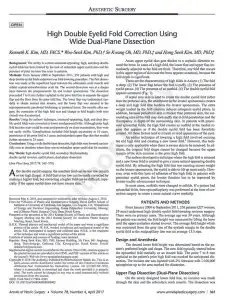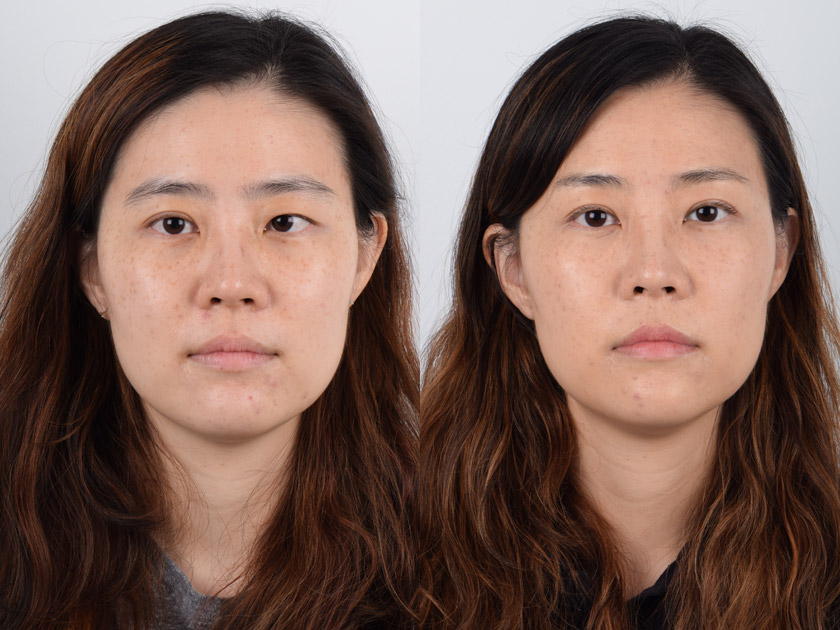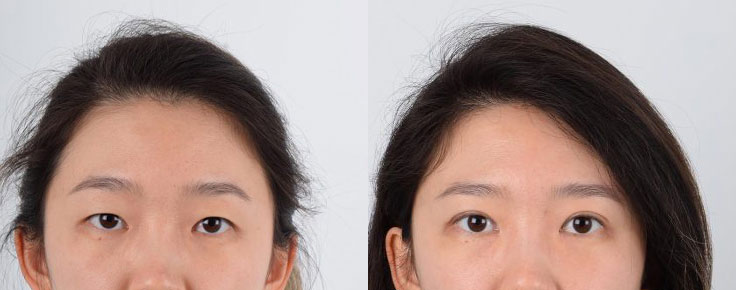There are various double eyelid revision techniques to correct different conditions. The duration of the surgery will depend on the condition of each patient. The surgery takes place under local anesthesia, with or without oral sedatives. The skin stitches will be removed 4-6 days after the surgery at our office. The critical swelling will subside in 1 week, and the remaining swelling will subside gradually within 8-12 weeks.
Revision Double Eyelid
 Many patients come to consult at my Los Angeles plastic surgery practice due to an unsuccessful double eyelid surgery operation from the past. This has become a serious issue among Asian patients; many undergo surgery anticipating the best possible results, only to be dissatisfied with the way they look afterwards. Some of the most common cases for a revision double eyelid surgery are described below.
Many patients come to consult at my Los Angeles plastic surgery practice due to an unsuccessful double eyelid surgery operation from the past. This has become a serious issue among Asian patients; many undergo surgery anticipating the best possible results, only to be dissatisfied with the way they look afterwards. Some of the most common cases for a revision double eyelid surgery are described below.
Conditions Corrected
HIGH FOLD
A remedy to this case is to release the high fold and recreate the fold at a lower height.
This issue is remedied by the creation of two planes around the formed scar tissue as a means to produce a buffer between the virgin skin (unscarred tissue) and the scarred tissue. This buffer prevents contact between the scar tissue from re-adhering to the virgin skin. Upon creating this buffer, the upper eyelid skin can be excised depending on how much it droops. Typically for younger patients, there is no need for this excision; however for older patients, who skin is less elastic, this upper eyelid skin excision is performed.
Upon releasing the previous fold, either the suture or open technique can be applied to create the lower, more suitable fold. Depending on how deep into the skin the prior crease was, a specific technique is used. For a crease that was very deep, the open technique is used; whereas for a crease that was weak, the suture technique is used.
LOOSENING FOLD
A decreasing fold often results from two causes. The first cause is the patient’s fatty eyelid skin. A patient who has undergone a suture technique may notice a loosening fold due to the sutures’ inability to support the crease. The second cause may be that the sutures were not placed tightly enough to support the crease. Whichever the case, the way to solve this problem is to reapply the suture technique to the eyes. This can be done with or without the removal of the previous sutures.
UPPER EYELID SCAR REVISION
Upper eyelid surgical scars can result due to poor suturing, static fold formation, or misalignment of where the fixation is made relative to muscle direction. Scar revision is a relatively simple procedure that requires the scar to be excised and the eyelid fold to be recreated.
RETRACTION CORRECTION
Patients may experience overly enlarged eyes where their upper sclera shows (i.e., white aspect of eye is visible on top of the iris). Correction of this can be accomplished by massage or revision double eyelid surgery. If caught early (within few weeks of surgery), this can be corrected by strengthening the eyelid muscle by means of a massage technique. If not caught in the early stages, retraction correction must be done surgically by reversing the ptosis correction and then creating a buffer with the patient’s own inherent scar tissue.
This procedure is advanced, as ptosis revision was traditionally done by grafting the patient’s ear cartilages or mucosa inside the mouth to create a buffer.
HEAVY EYES
Many times, patients can experience heaviness of their eyelid when they have ptosis, the weakening of the eyelid elevating muscle. Patients that have undergone eyelid surgery may also experience another form of heaviness due to puffiness (swelling) of their eyelid. If the patient is experiencing heaviness of the eyelids as a result of ptosis, the surgeon must strengthen the eye muscle by performing ptosis correction as part of revision double eyelid surgery.
PUFFINESS
There are two types of puffiness that can result in heavy eyelids–fullness in the area between the lash line and the crease or puffiness above the crease up to the brow.
- Sausage – When fullness occurs between the lash line and the crease, it is referred to as “sausage”. When the patient’s face is viewed from the side, the “sausage” area will protrude under the crease, appearing unnatural and unattractive. The cause of “sausage” can be due to the spontaneous development of ptosis or induced ptosis, where a patient’s eye muscle develops intolerance to a high fold. If this occurs due to spontaneous ptosis or induced ptosis, the heaviness can be alleviated by ptosis correction. If the heaviness occurs because the patient’s fold is too high, it can be corrected by lowering the fold.
- Crease to brow puffiness – Puffiness in the area between the fold and the brow can be corrected by removal of skin or with a brow lift. There are two types of brow lifts: a traditional brow lift, or a sub brow lift. A traditional brow lift (otherwise called forehead lift) involves lifting of the forehead and brow from or above the hairline and subsequently, the eyelid is lifted. A sub brow lift is done by excising a portion of skin immediately under the brow. Some individuals may require such brow lift when getting double eyelid surgery if their brow skin is too puffy or extremely thick.
What are the Common Reasons for Needing Revision Double Eyelid Surgery?
There are many causes of a poor double eyelid surgery result, necessitating revision double eyelid surgery . The top five reasons for patients to seek revision eyelid surgery or double eyelid surgery revisions are
- Fold loosening
- Uneven eyes
- Eyelid ptosis
- Hooding skin
- Visible scars
Fold loosening is one of the most common reasons for revision double eyelid surgery. Double eyelid fold loosening is especially common if the patient had non-cutting or non-incision double eyelid surgery. It is also known as the suture method or the stitch method double eyelid surgery. Eyelid fold loosening can also occur after an incision or open or cutting technique double eyelid surgery. When the double eyelid fold loosens, the skin between the fold and eyelash will appear puffy. In addition, the eyes will appear smaller because the skin will hood. In order to correct the loosened double eyelid fold, another suture method can be performed. However, in order to have a more definitive correction, it is advisable to have an incision technique double eyelid surgery to have a more secure and permanent double eyelid fold.
Uneven eyelids are another common reason why patients choose to undergo double eyelid revision surgery. There are many reasons for eyelid unevenness.
In addition to eyelid fold loosening, another common reason for uneven eyelid is when the double eyelid fold was made, the surgeon made the fold asymmetrically. This can happen if the double eyelid fold design is made unevenly or it the cut was made unevenly. During the original surgery, the double eyelid fold could also have been fixed to the deeper layer asymmetrically. For example, the eyelid skin could have been attached to the upper part of the levator aponeurosis or the tarsus on one side or to the levator aponeurosis or the tarsus on the lower side of the opposite side of the eye.
Another important factor for causing eyelid unevenness or asymmetry is eyelid ptosis. Eyelid ptosis is when the eyelid elevating muscle known as the levator muscle or levator aponeurosis is weak. When this occurs, the eye with the ptosis will appear smaller. However, the double eyelid itself will appear larger or bigger because the eyelid does not lift up as well. This eyelid ptosis condition can be unilateral or bilateral in nature.
Another reason is asymmetric eyelid hooding. One side of the upper eyelid can hood more than the other side.
This will make the hooding side of the double eyelid fold appear smaller than the other side. Hooding of the eyelid skin can be due to upper eyelid skin sagging itself or it can be due to brow or forehead hooding.
Lastly, a double eyelid scar is another common reason why patients choose to undergo double eyelid surgery revision. When there is a scar on the double eyelid fold, the scar is very visible even with makeup. This is especially noticeable when the patient opens and closes his or her eyes. The double eyelid fold does not move because the scar is stuck down to the deep layer of the eyelid tissue. In addition, the double eyelid scar is wide. Ideally, the double eyelid scar should be a line of less than 1mm. If the double eyelid scar is prominent, the patient may become self-conscious and it becomes a strong motivator to have a revision double eyelid surgery or revision Asian eyelid surgery.
Alterations

The revision surgeon must have an expertise in eyelid surgeries to calibrate the depth of the crease by understanding the individual’s thickness of skin, fat, and muscle, and muscle strength, as these components may vary from person to person.
HIGH TO LOW FOLD HEIGHT
A patient can seek revision surgery to change a high fold from their initial double eyelid surgery to a lower fold due to: the patient changing their mind, an inadvertent high fold as a result of a weak eye muscle (see Ptosis), or an inadvertent high fold as a result of surgeon fixing fold to the high aspect of the eye muscle rather than the lower aspect as the surgeon had intended. The method for correcting this complication can depend on the presence of excess eyelid skin and the cause of the high fold.
- Excess Skin – If the patient has excess skin (some signs of hooding), the surgeon simply corrects the high fold by excising excess skin and creating a newer fold at a lower aspect of the eyelid.
- No Excess Skin – When the patient does not have redundant or excess skin, the surgeon dissects the fold in two separate planes and releases the high fold. Additionally, a buffer (most of the time with fat) is placed on the upper eyelid and the skin is then reset to the lower aspect of the elevating muscle in order to prevent reattachment. If excess fat does not exist and cannot be mobilized by wide dissection of the eyelid, fat must be grafted from another area of the patient’s body. Furthermore, if the eyelid muscle is weak, ptosis correction must also be performed.
LOW TO HIGH FOLD HEIGHT
SHALLOW FOLD DEPTH
TOO DEEP FOLD DEPTH
A fold that is too strong can cause the crease to look static and unnatural. A static fold is when the fold does not change with eye movement (i.e., the fold should soften with eye closure and sharpen with eye opening). A deep fold typically results when the skin is attached to the eye elevating muscle too high (i.e., was not attached to a surgically created septo-levator complex) or when the skin is attached to the tarsus. In order to correct this problem, the surgeon must dissect and release the fold and place the new fold at an ideal anatomical location with adequate depth.
Recovery

Annals of Plastic Surgery, Vol. 78, No. 4
April 2017
Using a wide double-layer dissection, high folds were lowered success- fully even in situations where there was no redundant upper eyelid skin for excision. Read article for further information.
EYE SURGERY
- Asian Eyelid Surgery
- Asian Eyelid Anatomy
- Awake Blepharoplasty
- Lower Blepharoplasty
- Droopy Eyelid Correction
- Double Eyelid Surgery
- Instant Non-Surgical Double Eyelid Surgery
- Double Eyelid Surgery for Younger Patients
- Double Eyelid Surgery with Ptosis Correction
- Double Eyelid Surgery Before and After
- Dynamic Open Technique
- Eyelid Lift Before and After
- Eyelid Crease Specifications
- Lateral Canthoplasty
- Lower Eyelid Fat Removal
- Ptosis Repair
- Non-Surgical Ptosis Correction
- Revision Double Eyelid
- Sub-Brow Lift
- Suture Technique Double Eyelid
- Vector-Calibrated Incisional Technique (VCIT)
- Youthful Eyelid
- 3 Dimensional Suture Technique Double Eyelids Surgery














